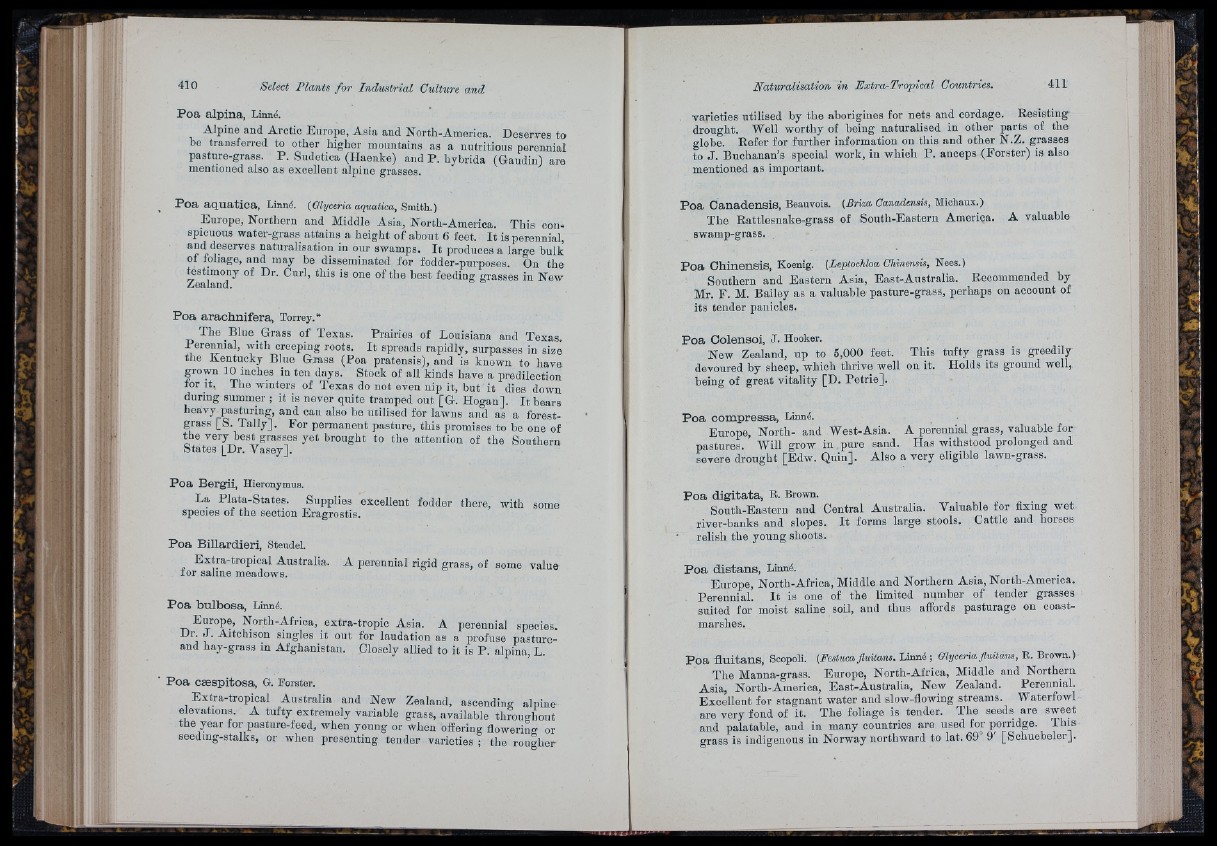
P o a a lp in a , Linné.
Alpine and Arctic Europe, Asia and North-America. Deserves to
be transferred to other higher mountains as a nutritious perennial
pasture-grass. P. Sndetica (Haeiike) and P. hybrlda (Gandin) are
mentioned also as excellent alpine grasses.
P o a a q u a tic a , Linné. {Olyceria aquatica. Smith.)
Europe, Northern and Middle Asia, North-America. This conspicuous
water-grass attains a height of about 6 feet. I t is perennial,
and deserves naturalisation in onr swamps. I t produces a large bulk
of foliage, and may be disseminated for fodder-purposes. On the
testimony of Dr. Cnrl, this is one of the best feeding grasses in New
Zealand.
P o a a r a c h n ife ra , Torrey.*
The Blue Grass of Texas. Prairies of Louisiana and Texas
Perennial, with creeping roots. I t spreads rapidly, surpasses iu sizè
the Kentucky Blue Grass (Poa pratensis), and is known to have
grown 10 inches in ten days. Stock of all kinds have a predilection
for it. The winters of Texas do not even nip it, but it dies down
during summer ; it is never quite tramped out [G. Hogan], I t bears
heavy pasturing, and can also be utilised for lawns and as a forest-
grass [S. Ta lly ]. For permanent pasture, this promises to be one of
the very best grasses yet brought to the attention of the Southern
States (Dr. Vasey].
P o a Bergii, Hieronymus.
La Plata-States. Supplies excellent fodder there, with some
species of the section Eragrostis.
P o a BiUardieri, Steudel.
Extra-tropioal Australia. A perennial rigid grass, of some value
for saline meadows.
P o a b u lb o s a , Linné.
Europe, North-Africa, extra-tropic Asia. A perennial species.
Dr J . Aitchison singles it out for laudation as a profuse pastiire-
and hay-grass in Afghanistan. Closely allied to it is P . alpina, L.
P o a cæ sp ito s a , G. Forster.
Extra-tropical Australia and New Zealand, ascending alpine
rievations. A tufty extremely variable grass, available tliroughont
the year for pasture-feed, when young or when offering flowering or
seeding-stalks, or when presenting tender varieties ; the rougher
varieties utilised by the aborigines for nets and cordage. Resisting
drought. Well worthy of being naturalised in other parts of the
globe. Refer for further information on this and other N.Z. grasses
to J . Buchanan’s special work, in which P. anceps (Forster) is also
mentioned as important.
P o a C a n a d e n s is , Beauvois. (B rim Canadensis, Michaux.)
The Rattlesnake-grass of South-Eastern America,
swamp-grass.
A valuable
P o a C h in en sis, Koenig. (Leptochloa Chinensis, Nees.)
Southern and Eastern Asia, East-Australia. Recommended by
Mr. F. M. Bailey as a valuable pasture-grass, perhaps on account of
its tender panicles.
P o a Colensoi, J . Hooker.
New Zealand, up to 5,000 feet. This tufty grass is greedily
devoured by sheep, which thrive well on it. Holds its ground well,
being of great vitality [D. Petrie].
P o a c om p re s s a , Linné.
Europe, North- and West-Asia. A perennial grass, valuable for
pastures. Will grow in pure sand. Has withstood prolonged and
severe drought [Edw. Quin]. Also a very eligible lawn-grass.
P o a d ig ita ta , B. Brown.
South-Eastern and Central Australia. Valuable for fixing wet
river-banks and slopes. I t forms large stools. Cattle and horses
relish the young shoots.
P o a d is ta n s , Linné.
Europe, North-Africa, Middle and Northern Asia, North-America.
Perennial. I t is one of the limited number of tender grasses
suited for moist saline soil, and thus affords pasturage on coast-
marshes.
P o a flu ita n s , Soopoli. (Festucafluitans. Linné; Glyceriafluitans, R. Brown.)
The Manna-grass. Europe, North-Africa, Middle and Northern
Asia, North-America, East-Australia, New Zealand. Perennial.
Excellent for stagnant water and slow-flowing streams. Waterfowl
are very fond of it. The foliage is tender. The seeds are sweet
and palatable, and in many countries are used for porridge. This
grass is indigenous in Norway northward to lat. 69° 9' [Schuebeler].